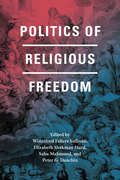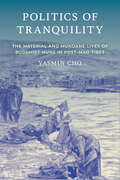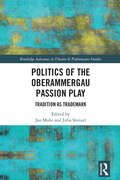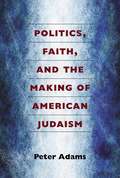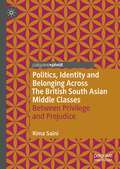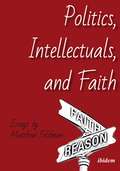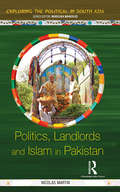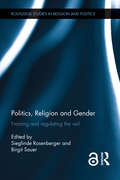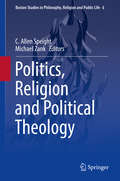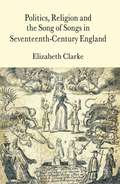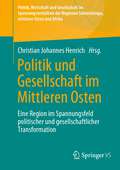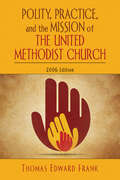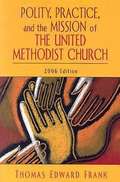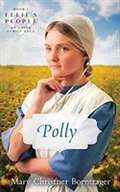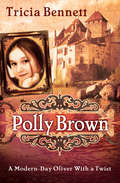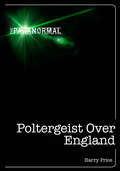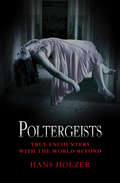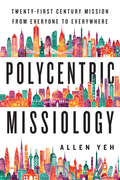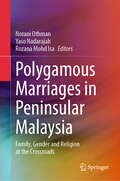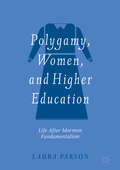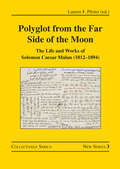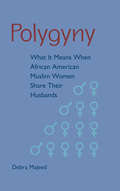- Table View
- List View
Politics of Religious Freedom (South Atlantic Quarterly Ser. #Vol. 113)
by Saba Mahmood Elizabeth Shakman Hurd Peter G. Danchin Winnifred Fallers Sullivan, Elizabeth Shakman Hurd, Saba Mahmood, and Peter G. DanchinIn a remarkably short period of time, the realization of religious freedom has achieved broad consensus as an indispensable condition for peace. Faced with widespread reports of religious persecution, public and private actors around the world have responded with laws and policies designed to promote freedom of religion. But what precisely is being promoted? What are the cultural and epistemological assumptions underlying this response, and what forms of politics are enabled in the process? The fruits of the three-year Politics of Religious Freedom research project, the contributions to this volume unsettle the assumption—ubiquitous in policy circles—that religious freedom is a singular achievement, an easily understood state of affairs, and that the problem lies in its incomplete accomplishment. Taking a global perspective, the more than two dozen contributors delineate the different conceptions of religious freedom predominant in the world today, as well as their histories and social and political contexts. Together, the contributions make clear that the reasons for persecution are more varied and complex than is widely acknowledged, and that the indiscriminate promotion of a single legal and cultural tool meant to address conflict across a wide variety of cultures can have the perverse effect of exacerbating the problems that plague the communities cited as falling short.
Politics of Tranquility: The Material and Mundane Lives of Buddhist Nuns in Post-Mao Tibet
by Yasmin ChoPolitics of Tranquility concerns the Tibetan Buddhist revival in China, illustrating the lives of Tibetan Buddhist nuns and exploring the political effects that arise from their nonpolitical daily engagements in the remote, mega-sized Tibetan Buddhist encampment of Yachen Gar. Yasmin Cho's book challenges two assumptions about Tibetan Buddhist communities in China. First, against the assumption that a Buddhist monastic community is best understood in terms of its esoteric qualities, Cho focuses on the material and mundane daily practices that are indispensable to the existence and persistence of such a community and shows how deeply gendered these practices are. Second, against the assumption that Tibetan politics toward the Chinese state is best understood as rebellious, incendiary, and centered upon Tibetan victimhood, the nuns demonstrate how it can be otherwise. Tibetan politics can be unassuming, calm, and self-contained and yet still have substantial political effects. As Politics of Tranquility shows, the nuns in Yachen Gar have called forth an alternative way of living and expressing themselves as Tibetans and as female monastics despite a repressive context.
Politics of the Oberammergau Passion Play: Tradition as Trademark (Routledge Advances in Theatre & Performance Studies)
by Jan Mohr Julia StenzelThis collection provides a comprehensive overview of the Oberammergau Passion play and its history from the 19th century onwards. Specialists in theatre and performance studies, comparative literature, theology, political studies, history, and ethnology initiate an interdisciplinary discussion of how Oberammergau has built a trademark from tradition. A typological and historical outline of this development is followed by detailed analyses of the blending of spaces, temporalities, and cultures, through which Oberammergau as an institution is stabilized while at the same time remaining open to the dynamics of historical change. The authors comprise the formation of a theatrical public sphere, literary imaginations, and layers of authenticity in modern practices of distributed communication that culminate in the notion of tradition as trademark. This collection is analysed from a wide spectrum of cultural historical perspectives, ranging from literary studies, theatre and performance studies to theology, political studies, and ethnology.
Politics, Faith, And The Making Of American Judaism
by Peter AdamsIn 1862, in the only instance of a Jewish expulsion in America, General Ulysses S. Grant banished Jewish citizens from the region under his military command. Although the order was quickly revoked by President Lincoln, it represented growing anti-Semitism in America. Convinced that assimilation was their best defense, Jews sought to Americanize by shedding distinctive dress, occupations, and religious rituals. American Jews recognized the benefit and urgency of bridging the divide between Reform and Orthodox Judaism to create a stronger alliance to face the challenges ahead. With Grant’s 1868 presidential campaign, they also realized they could no longer remain aloof from partisan politics. As they became a growing influence in American politics, both political parties courted the new Jewish vote. Once in office, Grant took notice of the persecution of Jews in Romania and Russia, and he appointed more Jews to office than any president before him. Indeed, Simon Wolf, a Washington lawyer who became one of Grant’s closest advisers, was part of a new generation of Jewish leaders to emerge in the post–Civil War era—thoroughly Americanized, politically mature, and committed to the modernized Judaism of the Reform movement. In Politics, Faith, and the Making of American Judaism, Peter Adams recounts the history of the American Jewish Community’s assimilation efforts, organization, and political mobilization in the late 19th century, as political and cultural imperatives crafted a new, American brand of Judaism.
Politics, Identity and Belonging Across The British South Asian Middle Classes: Between Privilege and Prejudice (Palgrave Politics of Identity and Citizenship Series)
by Rima SainiThis book will discuss the growing socio-economic and political diversity of the groups that comprise the British South Asian diaspora, with a focus on the formation of the British South Asian "middle classes". They will be framed within this work as a heterogenous sub-population, but this book is be the first comprehensive effort to define them sociologically as a distinct ethnoracial collective with a unique political profile. It does this with reference to secondary statistical data and primary interview data, and engages with relevant academic and non-academic literature. It describes the ways in which socially mobile South Asian migrants and particularly their descendants in the UK relate to their racial, ethnic, religious, classed and gendered identities, their relationship with ‘Britishness’, and their politics. It will therefore be of interest to students and researchers of political sociology, particularly those specialising in race, processes of racism and racialisation, ethnic and ethno-religious identity, class and social mobility amongst ethnic minority groups, and the interaction between minority identity and political identity.
Politics, Intellectuals, and Faith: Essays
by Matthew FeldmanThis wide-ranging collection of academic essays examines the various undertakings by modern intellectuals and ideologues in the process of propaganda and political debate. Matthew Feldman calls attention to the substantial role played in post-Great War Europe and the US by religions—both familiar monotheisms like Christianity and secular ‘political faiths’—over the last century of upheaval and revolutionary change. While the first part considers Ezra Pound as a case study in fascist ʼconversion’ in Mussolini’s Italy, leading to extensive propaganda, the second half examines other fascist ideologues like Martin Heidegger to fascist murderer Anders Behring Breivik, before turning to other leading ideologies in modern Europe and the US, communism and liberalism, covering key figures from Thomas Merton and Albert Camus to the Russian Constructionists and Samuel Beckett, with especial focus on the subjects of modern warfare, political terrorism, and genocide, ranging from Stalinist gulags to the war in Iraq. With thought-provoking discussion of the interplay between belief and modern politics as understood by familiar intellectual voices, this volume will be of interest to scholars and general readers alike.
Politics, Landlords and Islam in Pakistan (Exploring the Political in South Asia)
by Nicolas MartinThis book offers unique insights into the changing nature of power and hierarchy in rural Pakistan from colonial times to present day. It shows how electoral politics and the erosion of traditional patron–client ties have not empowered the lower classes. The monograph highlights the persistence of debt-bondage, and illustrates how electoral politics provides assertive landlord politicians with opportunities to further consolidate their power and wealth at the expense of subordinate classes. It also critically examines the relationship between local forms of Islam and landed power. The volume will be of interest to scholars and researchers on Pakistan and South Asian politics, sociology and social anthropology, Islam, as also economics, development studies, and security studies.
Politics, Religion and Gender: Framing and Regulating the Veil (Routledge Studies in Religion and Politics)
by Sieglinde Rosenberger and Birgit SauerHeated debates about Muslim women's veiling practices have regularly attracted the attention of European policymakers over the last decade. The headscarf has been both vehemently contested by national and/or regional governments, political parties and public intellectuals and passionately defended by veil wearing women and their supporters. Systematically applying a comparative perspective, this book addresses the question of why the headscarf tantalises and causes such controversy over issues about religious pluralism, secularism, neutrality of the state, gender oppression, citizenship, migration, and multiculturalism. Seeking also to establish why the issue has become part of the disciplinary practices of some European countries but not of others, this work brings together an important collection of interpretative research regarding the current debates on the veil in Europe, offering an interdisciplinary scope and European-wide setting. Brought together through a common research methodology, the contributors focus on the different religious, political and cultural meanings of the veiling issue across eight countries and develop a comparative explanation of veiling regimes. This work will be of great interest to students and scholars of religion & politics, gender studies and multiculturalism.
Politics, Religion and Political Theology
by C. Allen Speight Michael ZankThis new volume gives discursive shape to several key facets of the relationship among politics, theology and religious thought. Powerfully relevant to a wealth of further academic disciplines including history, law and the humanities, it sharpens the contours of our understanding in a live and evolving field. It charts the mechanisms by which, contrary to the avowed secularism of many of today's polities, theology and religion have often, and sometimes profoundly, shaped political discourse. By augmenting this broader analysis with a selection of authoritative papers focusing on the prominent sub-field of political theology, the anthology offsets a startling academic lacuna. Alongside focused analysis of subjects such as conscience, secularism and religious tolerance, the discussion of political theology examines the tradition's critical moments, including developments during the post-World War I Weimar republic in Germany and the epistemological imprint the theory has left behind in works by political thinkers influenced by the three major monotheistic traditions.
Politics, Religion and the Song of Songs in Seventeenth-Century England
by Elizabeth ClarkeThe Song of Songs , with its highly sexual imagery, was very popular in seventeenth-century England in commentary and paraphrase. This book charts the fascination with the mystical marriage, its implication in the various political conflicts of the seventeenth century, and its appeal to seventeenth-century writers, particularly women.
Politics, Religion, and Culture in an Anxious Age
by John BuellAmerican politics is increasingly driven by apocalyptic rhetoric. Highlighting possible adverse consequences of such politics for our freedom and quality of life, the book suggests alternative policy agendas, religious and philosophical discourses, cultural framing and modes of daily living
Politik und Gesellschaft im Mittleren Osten: Eine Region im Spannungsfeld politischer und gesellschaftlicher Transformation (Politik, Wirtschaft und Gesellschaft im Spannungsverhältnis der Regionen Südosteuropa und Mittlerer Osten)
by Christian Johannes HenrichIn diesem Sammelband werden die historischen, politischen und gesellschaftlichen Facetten der politischen Systeme der einzelnen Länder des Mittleren Ostens analysiert. Auch die Transformationsprozesse in den Gesellschaften im Kontext des Arabischen Frühlings, des Krieges in Syrien, des Bürgerkriegs in Libyen oder des Putsches in Ägypten spielen eine zentrale Rolle. Ebenfalls wird Israel beleuchtet, das als unvollständige Demokratie der einzige Hoffnungsschimmer im Umfeld zahlreicher autoritärer und totalitärer Systeme ist. Die Region ist zudem aufgrund der energiepolitischen Abhängigkeit sehr wichtig für die Europäische Union.
Polity, Practice, and the Mission of The United Methodist Church: 2006 Edition
by Thomas E. Frank"Commissioned by the General Board of Higher Education and Ministry for use in United Methodist doctrine/polity/history courses." This in-depth analysis of the connection between United Methodist polity and theology addresses ways in which historical developments have shaped--and continue to shape--the organization of the church.This revised edition incorporates the actions of The United Methodist General Conference, 2004. The book discusses continuing reforms of the church's plan for baptism and church membership, as well as the emergence of deacon's orders and other changes to ordained ministry procedures. The text is now cross-referenced to the Book of Discipline, 2004, including the revised order of disciplinary chapters and paragraph numbering. Denominational statistics are updated, along with references to recent works on The United Methodist Church and American religious life.
Polity, Practice, and the Mission of the United Methodist Church 2006
by Thomas Edward Frank"Commissioned by the General Board of Higher Education and Ministry for use in United Methodist doctrine/polity/history courses. " This in-depth analysis of the connection between United Methodist polity and theology addresses ways in which historical developments have shaped--and continue to shape--the organization of the church. This revised edition incorporates the actions of The United Methodist General Conference, 2004. The book discusses continuing reforms of the church's plan for baptism and church membership, as well as the emergence of deacon's orders and other changes to ordained ministry procedures. The text is now cross-referenced to the Book of Discipline, 2004, including the revised order of disciplinary chapters and paragraph numbering. Denominational statistics are updated, along with references to recent works on The United Methodist Church and American religious life.
Polly (Ellie's People Ser. #7)
by Mary Borntrager"Polly Miller is confused. Why is her family moving to Texas? Will she have friends there? This great-granddaughter of Ellie (Ellie's People, book 1) belongs to a close-knit Amish family and community in Ohio. Her dad says they can earn more money in Texas to pay off their farm in Ohio. But he doesn't understand Polly's need for companionship. Polly finds a friend in Rose Ann, an englisch girl her age. Then she secretly sneaks out with Tom Dawson, a cowboy and rodeo performer. Tragedy stalks her. Will she find her way back to her Amish roots?" Look for this engrossing series about the lives of young people growing up, working, playing, falling in love and living according to the Amish and Mennonite religions of their families and friends. Look for #1 Ellie, #2 Rebecca, #3 Rachael, #4 Daniel, #5. Reuben, #6. Andy, #8. Sarah, #9. Mandy and #10. Annie.
Polly Brown: A Modern-Day Oliver With a Twist
by Tricia BennettPolly Brown is a young orphan girl, who struggles to cope with life in the harsh environment of a children&’s home. The story is set in a genteel English country town. One day a mysterious stranger knocks at the door and invites her on a roller-coaster, whirlwind adventure that changes her life forever. She begins a voyage of self-discovery, where she finds out that dreams can come true if you pursue them with all your heart.Polly Brown is an authentic story that walks readers through hardship and joys. Young adults will sympathize with Polly's difficult and authentic journey from negativity to faith in God's guiding over her life. Her struggles are not glossed over, nor are they treated with a "just believe" attitude. Through Polly's honest talks with God, readers will learn how to pray and cultivate a real, relevant relationship with their Creator.
Poltergeist Over England: Three Centuries Of Mischievous Ghosts (The Paranormal)
by Harry PriceAn extensive study of poltergeist phenomena which covers many historical cases researched from Price's own extensive occult library such as the Tedworth Drummer, Hinton Ampner, Willington Mill and the Bealings Bells as well as featuring cases with which Harry Price had personal involvement, namely Stella C, Eleonore Zungun, the Battersea poltergeist house & Borley Rectory.Harry Price begins by introducing readers to poltergeists, explaining what poltergeists actually are, the historical background around poltegeists, and what they do, before discussing specific poltergeist cases. With 12 photographs and accompanying explanatory commentaries, showing various places of poltergeist sightings, as well as a photograph of a poltergeist subject, this ebook will leave you full of knowledge and intrigue surrounding poltergeist phenomena.The Paranormal, the new ebook series from F&W Media International Ltd, resurrecting rare titles, classic publications and out-of-print texts, as well as new ebook titles on the supernatural - other-worldly books for the digital age. The series includes a range of paranormal subjects from angels, fairies and UFOs to near-death experiences, vampires, ghosts and witchcraft.
Poltergeist! A Study in Destructive Haunting
by Colin WilsonA summary of various cases of unexplained phenomena in the occult world
Poltergeists: True Encounters With The World Beyond (True Encounters with the World Beyond #8)
by Hans HolzerParanormal expert Hanz Holzer investigates some of the most famous poltergeists in history Poltergeist is a German term that translates simply to “noisy ghost.” One of the main characteristics of a poltergeist is its high level of activity; it often manifests itself by moving or even throwing objects. Professor Hans Holzer reexamines these most menacing of hauntings, including the famous case of the Bell Witch of Tennessee, a nineteenth-century spirit, and the Millbrae Poltergeist, which crashes around a suburban home.
Polycentric Missiology: 21st-Century Mission from Everyone to Everywhere
by Allen YehThe Edinburgh 1910 World Missionary Conference was the most famous missions conference in modern church history. A century later, five conferences on five continents displayed the landscape of global mission at the dawn of the third millennium: Tokyo 2010, Edinburgh 2010, Cape Town 2010, 2010Boston, and CLADE V (San José, 2012). These five events provide a window into the state of world Christianity and contemporary missiology. Missiologist Allen Yeh, the only person to attend all five conferences, chronicles the recent history of world mission through the lenses of these landmark events. He assesses the legacy of Edinburgh 1910 and the development of world Christianity in the following century. Whereas Edinburgh 1910 symbolized Christendom's mission "from the West to the rest," the conferences of 2010-12 demonstrate the new realities of polycentric and polydirectional mission—from everyone to everywhere. Yeh's accounts of the conferences highlight the crucial missiological issues of our era: evangelism, frontier missions, ecumenism, unengaged and post-Christian populations, reconciliation, postmodernities, contextualization, postcolonialism, migration, and more. What emerges is a portrait of a contemporary global Christian mission that encompasses every continent, embodying good news for all nations.
Polydoxy: Theology of Multiplicity and Relation
by Catherine KellerReligious pluralism, the collapse of traditional religious institutions, and the growing impact of religious studies on believers have prompted widespread rethinking of what religion is. Polydoxy offers a brilliant and original theological response to this intellectual crisis by suggesting that there are multiple forms of right belief. Reacting against reductive or nostalgic theological tendencies, the chapters in this book by an impressive array of scholars take an exciting and creative approach to theology in the twenty-first century.
Polygamous Marriages in Peninsular Malaysia: Family, Gender and Religion at the Crossroads
by Norani Othman Yaso Nadarajah Rozana Mohd IsaThis book presents the first national study of the practice of polygamy undertaken amongst Malay Muslims, contextualised within the broader social, legal, and political context of Malaysia. A collaboration between the Sisters in Islam NGO and three universities in Malaysia, it examines the perspectives of both men and women through quantitative and qualitative data analysis of over 1,200 surveys and more than 60 in-depth interviews charting the legal, financial, social, and emotional impacts of polygamy. It incorporates both progressive Islamic scholarly thought and the unique sociologically rich perspectives of the study respondents. In doing so, the data serves to strengthen advocacy for awareness and law reforms within Islamic jurisprudence frameworks and institutions. As one of the most comprehensive surveys ever conducted on polygamy in a Muslim society, this represents a major tour de force within a little explored field with tremendous potential for societal impact. This book is relevant to academics and graduate students seeking a deeper understanding of the issues related to Muslim polygamous marriage and to researchers within the broader fields of gender studies, family studies, Islamic studies, and Islamic legal studies. It is also a landmark resource for activists and policymakers seeking to advocate on behalf of marginalised groups—particularly women and children in polygamous families.
Polygamy, Women, and Higher Education: Life After Mormon Fundamentalism
by Laura ParsonThis volume explores the life stories of women who were former members of Mormon fundamentalist polygamous societies, from their own perspectives, to seek insight into their readiness for higher education settings. In order to support all learners in higher education, it is important to understand the unique needs of women students who have non-traditional formal schooling experiences and/or have come from restrictive or patriarchal cultures. This book helps further the discourse by providing recommendations for inclusive programs that consider how to develop elements of self-concept, empowerment, and motivation necessary for higher education success—academically and beyond.
Polyglot from the Far Side of the Moon: The Life and Works of Solomon Caesar Malan (1812–1894) (Collectanea Serica. New Series #3)
by Lauren F. PfisterThough recognized in the latter part of the 19th century as "the greatest Orientalist in Britain," the Geneva-born Anglican priest, Solomon Caesar Malan (1812–1894) was such an extraordinary person that he has defied any scholarly person to write a critical account of his life and works. Consequently, almost no one has written anything critically appreciative and insightful about him since his death. A polymath with extraordinary talent for languages and sketching, among other specialized skills, Malan focused much of his life on assessing biblical translations in ancient Middle Eastern and East Asian languages, while also producing English translations of alternative expressions of Christianity found in north Africa, the Middle East, and Asia. A life-long interest of his was comparing the proverbs of his name-sake, King Solomon, with proverbial wisdom from as many cultures and languages as he could find. That interest culminated in a three-volume work that enshrined his achievements realized through his capacities as a hyperpolyglot within the context of a search for shared wisdom across many cultures. In this volume, produced by a team of collaborators from a wide range of scholarly interests and varying expertise, we have presented a critically assessed account of the life and key works produced by Solomon Caesar Malan. In fact, it is the first work of its kind on Malan written since his death, now having occurred more than 125 years ago. Readers will journey through an itinerary that starts in Geneva before it became part of Switzerland, moves to Great Britain, and ultimately into one of the colleges in Oxford. Subsequently, it moves us into an exploration of the journey of his life that involved a huge range of places, people, and languages: starting in Calcutta, touching unusual figures from Hungary, India, and China. Those seminal experiences led Malan into studies of languages related to even more distant cultural worlds in Central, Southeastern, and East Asia. The historians among us have delved into Malan’s life in Calcutta, Geneva, and Dorsetshire, while others have explored the nature of his hyperpolyglossia, and tested the quality of his understanding of ancient literature in classical languages that include Chinese, Manchurian, Sanskrit and Tibetan. Notably, Malan’s personal library was so unique, that when he donated it to his alma mater at Oxford University, it became one of the major bibliographic precedents for what is now the Oriental Division in the Bodleian Libraries. Yet, when one follows the twists and turns of his life’s journey, and the surprises that occur from documenting the history and content of the Malan Library as well as critically analysing aspects of his opus magnum, Original Notes on the Book of Proverbs (1889–1893), we believe both general readers and scholarly specialists will be entranced.
Polygyny: What It Means When African American Muslim Women Share Their Husbands
by Majeed Majeed"Captivating, provocative, and groundbreaking. Taking up the mandate that women's realities matter, Majeed writes with depth and analytical rigor about a topic we have scarcely begun to understand."--Amina Wadud, author of Inside The Gender Jihad "Tackles the contours and intimacies of a much practiced but seldom spoken about quasi-marriage that leaves women without legal support. A much-needed text on an extremely sensitive topic. Majeed excavates this terrain with finesse and a deft scholarly hand."--Aminah Beverly McCloud, coeditor of An Introduction to Islam in the 21st Century "Utilizes ethnographic research methods to imaginatively and constructively complexify the reality of polygyny in the lives of African American Muslim women."--Linda Elaine Thomas, author of Under the Canopy "Majeed's womanist approach is critical, yet balanced enough to include the concerns of women, men, and children, affording readers a broad and vital gaze into the lives of these unconventional households."--Zain Abdullah, author of Black Mecca "A powerful and long overdue study of polygyny in African American Muslim communities."--Shabana Mir, author of Muslim American Women on Campus Debra Majeed sheds light on families whose form and function conflict with U.S. civil law. Polygyny--multiple-wife marriage--has steadily emerged as an alternative to the low numbers of marriageable African American men and the high number of female-led households in black America. This book features the voices of women who welcome polygyny, oppose it, acquiesce to it, or even negotiate power in its practices. Majeed examines the choices available to African American Muslim women who are considering polygyny or who are living it. She calls attention to the ways in which interpretations of Islam's primary sources are authorized or legitimated to regulate the rights of Muslim women. Highlighting the legal, emotional, and communal implications of polygyny, Majeed encourages Muslim communities to develop formal measures that ensure the welfare of women and children who are otherwise not recognized by the state. Debra Majeed is professor of religious studies at Beloit College.
